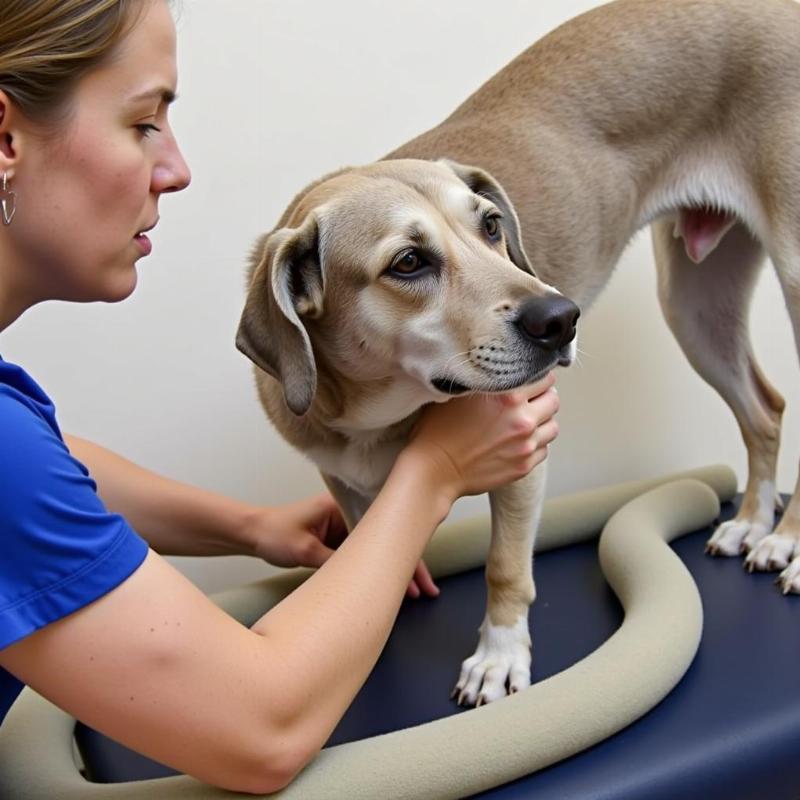If your dog suddenly can’t stand up, it can be a terrifying experience. This inability to bear weight can signal a range of issues, from minor injuries to serious medical conditions. Understanding the potential causes and knowing what steps to take is crucial for your dog’s well-being. This article will guide you through the possible reasons why your dog might be experiencing this sudden inability to stand, offer advice on what to do, and provide insights into treatment and prevention.
Possible Causes of Sudden Inability to Stand in Dogs
A dog’s sudden inability to stand can stem from various factors. Trauma, such as a fall or being hit by a car, is a common cause, potentially leading to fractures, sprains, or dislocations. Neurological problems, including intervertebral disc disease (IVDD), can also cause weakness or paralysis in the legs. Other potential causes include:
- Tick-borne diseases: Lyme disease, ehrlichiosis, and Rocky Mountain spotted fever can cause joint inflammation and muscle weakness, making it difficult for dogs to stand.
- Infections: Certain viral or bacterial infections can affect the nervous system or musculoskeletal system, impacting a dog’s ability to support its weight.
- Metabolic disorders: Conditions like hypoglycemia (low blood sugar) can cause weakness and collapse.
- Toxins: Exposure to certain toxins can lead to neurological symptoms, including an inability to stand.
- Arthritis and other degenerative joint diseases: While these conditions typically develop gradually, a sudden worsening of symptoms can occur.
What to Do if Your Dog Can’t Stand Up
If your dog suddenly can’t stand up, it’s essential to remain calm and take immediate action:
- Assess the situation: Check for any obvious injuries, such as bleeding or broken bones. Observe your dog’s breathing and overall demeanor.
- Avoid moving your dog unnecessarily: If you suspect a spinal injury, improper handling could worsen the condition.
- Contact your veterinarian immediately: Describe your dog’s symptoms and the circumstances leading up to the inability to stand.
- Transport your dog carefully: If possible, use a stretcher or a firm, flat surface to transport your dog to the vet.
Diagnosis and Treatment
Your veterinarian will conduct a thorough physical examination and may recommend diagnostic tests such as X-rays, blood work, or MRI to determine the underlying cause of your dog’s inability to stand. Treatment will depend on the diagnosis and may include:
- Pain medication: To manage discomfort and inflammation.
- Antibiotics or antiviral medications: If an infection is present.
- Surgery: In cases of fractures, dislocations, or severe IVDD.
- Physical therapy: To help restore strength and mobility.
- Supportive care: Such as fluid therapy or nutritional support.
Prevention and Long-Term Care
While not all causes of sudden inability to stand are preventable, some measures can reduce the risk:
- Maintain a healthy weight: Obesity can strain joints and increase the risk of orthopedic problems.
- Provide regular exercise: Appropriate exercise helps keep muscles strong and joints healthy.
- Use a harness instead of a collar: This can reduce stress on the neck and spine, particularly in breeds prone to IVDD.
- Prevent access to toxins: Keep potentially harmful substances out of your dog’s reach.
- Regular veterinary checkups: Early detection and treatment of underlying medical conditions can help prevent mobility issues.
 Dog receiving physical therapy
Dog receiving physical therapy
Conclusion
If your dog suddenly can’t stand up, seeking immediate veterinary care is paramount. Early diagnosis and appropriate treatment can significantly improve your dog’s chances of recovery and help them regain mobility. By understanding the potential causes, knowing what to do in an emergency, and taking preventative measures, you can help ensure your dog’s long-term health and well-being.
FAQs
- My dog is old and can’t stand up. Is this normal? While mobility issues can become more common with age, a sudden inability to stand is never normal and requires veterinary attention.
- Could my dog be faking it? While dogs can exhibit attention-seeking behaviors, an inability to stand is a serious symptom and should not be dismissed.
- How long does it take for a dog to recover from an inability to stand? Recovery time varies depending on the underlying cause and the individual dog. It can range from a few days to several months or longer.
- What are the signs of pain in a dog that can’t stand? Signs of pain can include whimpering, panting, restlessness, changes in appetite, and reluctance to be touched.
- How can I make my dog comfortable if they can’t stand? Provide a soft, supportive bed and ensure they have access to food and water. Avoid moving them unnecessarily and follow your veterinarian’s instructions for pain management.
- Are certain dog breeds more prone to this issue? Yes, some breeds are predisposed to certain conditions that can cause an inability to stand, such as IVDD in Dachshunds and hip dysplasia in large breeds.
- What is the cost of treating a dog that can’t stand up? The cost of treatment varies depending on the diagnosis and the required interventions.
Beautdogs.us is your premier resource for all things dog-related in the US. We offer expert advice on dog breeds, care, and lifestyle, providing both new and experienced dog owners with reliable information. Our passion is empowering dog owners with the knowledge they need to provide the best possible care for their furry companions. For any questions or inquiries, contact us at [email protected] or call us at +1 501-555-7529. Visit Beautdogs.us for more information.